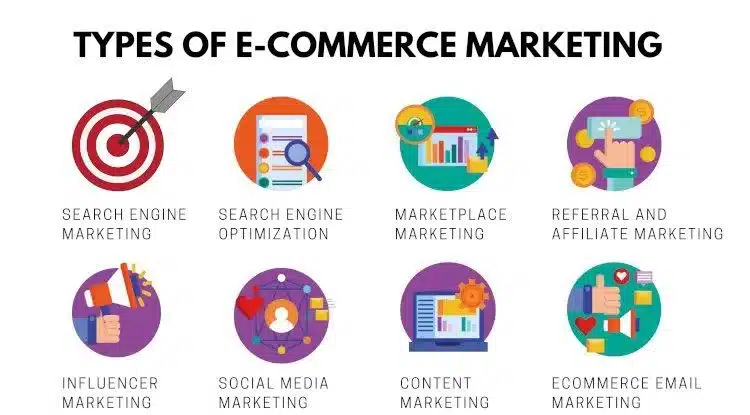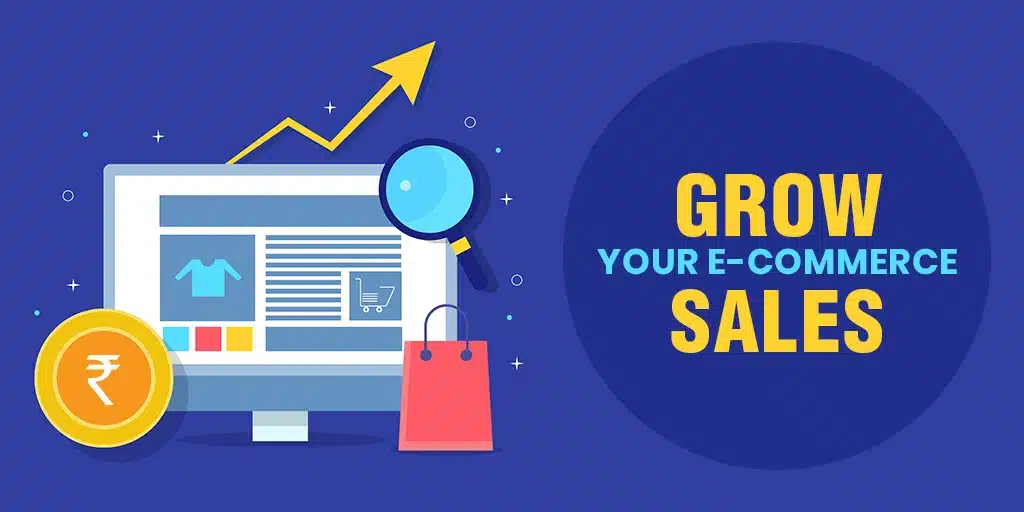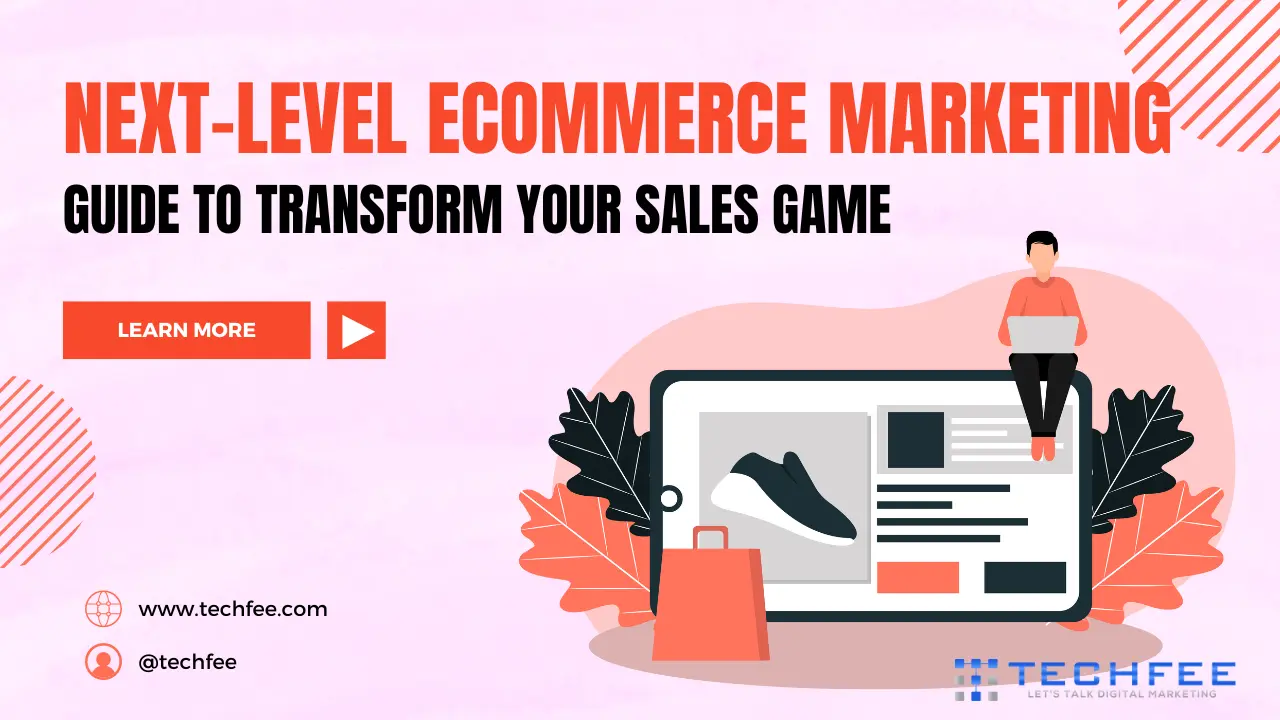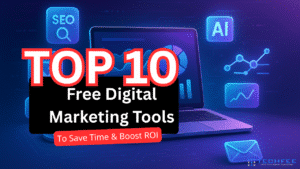Let’s unlock the potential of your online store with these expert tips on ecommerce marketing!
Imagine waking up one morning to find that your online sales have gone through the roof.
Your online store is doing better than ever now that you know how to make it work.
What if this is real? What if there are tried-and-true methods, sneaky tricks, and secret tips that can help you make this dream come true?
E-commerce marketing is essential for online shops to stay alive in this digital world. It brings in customers, keeps them interested, and increases sales.
E-commerce is changing quickly, and sales worldwide are expected to hit unbelievable levels.
According to Statista, the US e-commerce market was predicted to keep making more money, by 657.8 billion dollars (+53.79 percent), from 2024 to 2029. After ten years of going up, the indicator is expected to hit 1.9 trillion U.S. dollars in 2029, which would be a new high point.
Whether you’re a seasoned business owner or a new one, you must know how to do e-commerce marketing well to stay ahead of the competition.
This blog post will help you find your way around this ever-changing world.
It is full of helpful information and tips from experts that you can use to give your business the tools and strategies it needs to reach new heights.
Read on to learn how to change the way you market your e-commerce business and see massive gains!
What Is Ecommerce Marketing?

Ecommerce marketing is the process of using different types of digital marketing to get people to buy things from your online store.
It includes various strategies for attracting potential customers, keeping them interested, and turning them into paid customers.
These tactics include search engine optimization (SEO), content marketing, social media marketing, email campaigns, and paid ads.
The goal of e-commerce marketing is to get the right message to the right people at the right time. This will increase visibility, drive traffic, and eventually increase sales.
Businesses can use new techniques and insights gleaned from data to create targeted marketing campaigns that connect with their audience and improve their general online presence.
Types of Ecommerce Marketing

E-commerce marketing surrounds a variety of strategies to reach potential customers and boost sales.
Email Marketing involves sending personalized emails to your subscribers to promote products, offer discounts, and share updates.
It’s a powerful tool for building customer relationships and encouraging repeat purchases.
SMS Marketing leverages text messages to deliver promotions, alerts, and reminders directly to customers’ mobile devices.
With high open rates, SMS marketing effectively offers time-sensitive offers and fosters immediate engagement.
PPC Advertising (Pay-Per-Click) is a method where businesses pay a fee each time their ad is clicked.
Platforms like Google Ads allow you to display ads to users searching for relevant keywords, driving targeted traffic to your e-commerce site.
Search Engine Optimization (SEO) involves optimizing your website and content to rank higher in search engine results.
SEO helps attract organic traffic and increase visibility by using relevant keywords, creating valuable content, and improving site structure.
Content Marketing focuses on creating and distributing valuable, relevant content to attract and engage your target audience.
Blog posts, videos, and infographics educate and inform potential customers, establishing your brand as an authority in your niche.
Affiliate Marketing allows you to partner with affiliates who promote your products in exchange for a commission on sales.
This strategy expands your reach and leverages the affiliates’ audiences to drive more traffic and sales to your e-commerce site.
Social Media Marketing involves using platforms like Facebook, Instagram, and Twitter to promote your products, engage with customers, and build brand awareness.
Through organic posts and paid ads, social media marketing helps create a loyal customer base and drive traffic.
Influencer Marketing leverages the reach and credibility of influencers in your industry to promote your products.
Collaborating with influencers can significantly increase brand awareness and drive sales by tapping into their engaged followers.
By integrating these diverse types of e-commerce marketing, businesses can create comprehensive and effective marketing strategies that cater to their specific audience and goals.
How to Make an Ecommerce Marketing Plan
Creating an effective ecommerce marketing plan involves several key steps:
Define Your Goals: Establish clear objectives, such as increasing sales, growing your customer base, or boosting brand awareness.
Conduct Market Research: Understand your target audience, their preferences, and behaviors to tailor your marketing strategies effectively.
Analyze Competitors: Identify competitors’ strengths and weaknesses to uncover potential opportunities for your business.
Select Marketing Channels: Choose the most appropriate channels, such as email, social media, SEO, and PPC advertising, that align with your goals and audience.
Develop a Content Calendar: Plan your marketing activities to ensure consistent and timely execution.
Allocate Budget: Distribute your budget across chosen channels to maximize ROI.
Monitor Performance: Use analytics tools to track campaign performance and gather insights.
Adjust Strategies: Be prepared to tweak your strategies based on the data collected to optimize results.
Following these steps, you can create a comprehensive e-commerce marketing plan that drives traffic, engages customers, and boosts sales.
27 Ecommerce Marketing Tips to Increase Sales

1. Optimizing Your Ecommerce Website
Optimizing your e-commerce website is crucial for increasing sales, starting with enhancing user experience.
Intuitive Navigation ensures that customers can easily find what they’re looking for, leading to higher conversion rates.
Make your site is Mobile Responsive to accommodate the growing number of mobile shoppers and provide a seamless experience across all devices.
Improving Site Speed is another critical factor. Use techniques such as image compression, browser caching, and minimizing JavaScript to Boost Loading Times.
Faster loading speeds directly Impact Conversions, as users are more likely to abandon slow websites.
Craft Effective Product Descriptions by writing persuasive, engaging copy highlighting your products’ benefits.
Incorporate SEO Keywords naturally to improve search engine rankings and attract more organic traffic.
Finally, focus on High-Quality Product Images. The Importance of Visual Appeal cannot be overstated, as high-quality images can significantly influence purchasing decisions.
Follow Best Practices for Product Photography, such as using good lighting, multiple angles, and zoom features, to showcase your products in the best possible light.
2. Leveraging SEO for E-commerce
Leveraging SEO for e-commerce is essential for driving organic traffic and increasing sales.
Start with Keyword Research and Optimization by Identifying High-Value Keywords relevant to your products and audience.
Use tools like Google Keyword Planner or Ahrefs to find keywords with high search volume and low competition.
Implement On-Page SEO Strategies, such as optimizing meta titles, descriptions, headers, and incorporating keywords naturally within your content.
Content Marketing is another powerful SEO tactic. Focus on Creating Valuable Blog Posts that provide insights, tips, or tutorials related to your products. This will attract visitors and position your brand as an industry authority.
Incorporating Product Links Naturally within your blog posts can drive traffic directly to your product pages, enhancing the chances of conversion.
Finally, don’t overlook Technical SEO Enhancements. Use Structured Data and Schema Markup to help search engines understand your content better and improve how your products are displayed in search results.
Ensure your website’s Crawlability and Indexability by creating an XML sitemap, fixing broken links, and improving your site’s overall structure.
This helps search engines crawl and index your site efficiently, boosting your SEO performance.
3. Harnessing Social Media
Harnessing social media is a powerful way to increase e-commerce sales.
Start by Building a Strong Social Media Presence. Choosing the Right Platforms is crucial; focus on where your target audience spends most of their time, whether it’s Instagram, Facebook, TikTok, or LinkedIn.
Ensure Consistent Branding Across Channels by using the same logos, color schemes, and messaging to create a cohesive brand identity that customers can easily recognize.
Social Media Advertising can drive significant traffic and sales. Creating Engaging Ads with compelling visuals and persuasive copy can capture the audience’s attention.
Use advanced targeting options to Target the Right Audience, ensuring your ads reach potential customers who are most likely to be interested in your products.
Influencer Collaborations can amplify your reach and credibility. Start by Finding and Partnering with Influencers whose audience aligns with your target market.
Running an Influencer Marketing Campaign involves coordinating with influencers to promote your products through authentic content.
To ensure success, focus on Measuring Campaign Success by tracking key metrics such as engagement rates, click-through rates, and conversions. This data will help you refine future campaigns and maximize ROI.
By effectively leveraging social media, you can build a loyal customer base, increase brand awareness, and drive more sales for your e-commerce business.
4. Email Marketing Strategies
Email marketing remains a cornerstone of successful e-commerce strategies. It offers direct communication with your audience and the potential for significant sales growth.
Building an Email List begins with effective Strategies for List Growth.
Utilize opt-in forms on your website, offering incentives like discounts or content upgrades to encourage sign-ups.
Ensure the Importance of Segmentation by categorizing subscribers based on demographics, behavior, or purchase history to send targeted campaigns that resonate.
Crafting Compelling Email Campaigns involves creating content that is both Personalized and Relevant to each segment of your audience.
Tailor messages to their preferences and purchase history to increase engagement. Pay attention to the Timing and Frequency of Emails, ensuring you strike a balance between staying top-of-mind without overwhelming your subscribers.
Abandoned Cart Recovery emails are critical for recapturing potential sales. Use Effective Email Templates that remind customers of items left in their cart and include a clear call-to-action.
Experiment with the Timing and Frequency of Follow-Ups to find the optimal moment to re-engage.
To Capture more email subscribers, optimize your website and social media channels with compelling calls-to-action and ensure a seamless sign-up process.
To Improve your email campaigns, regularly analyze performance metrics like open rates and click-through rates, and A/B test different elements such as subject lines, content, and visuals.
5. Utilizing Paid Advertising
Utilizing paid advertising is a strategic approach to boosting e-commerce sales by reaching targeted audiences effectively.
Run PPC (pay-per-click) campaigns to drive immediate traffic and conversions.
Allocate budgets to platforms like Google Ads, where setting up Effective Campaigns involves selecting relevant keywords, crafting compelling ad copy, and optimizing landing pages.
Continuously Monitoring and Optimizing Performance ensures your campaigns remain cost-effective and aligned with your goals.
Google Ads for Ecommerce is particularly powerful. Focus on Setting Up Effective Campaigns by targeting specific product categories or demographics. Use analytics to refine your strategy, adjusting bids and keywords based on performance data.
Retargeting Campaigns are essential for re-engaging visitors who have shown interest in your products.
Craft compelling ads that Re-engage Previous Visitors by reminding them of products they viewed or added to their cart.
Implement Best Practices for Ad Creatives, such as clear calls-to-action and limited-time offers to encourage conversions.
Advertising on Marketplaces like Amazon offers additional opportunities.
Develop Strategies for Amazon Ads by optimizing product listings with relevant keywords and compelling visuals.
Consider leveraging eBay and Other Platforms to diversify your reach and attract new customers through targeted ads.
6. Sell on marketplaces
An intelligent way to grow your e-commerce business and make more sales is to sell on platforms.
Sites like Amazon, eBay, and Etsy let you reach millions of people who are constantly looking for products.
To get the most out of marketplaces, you need to make sure your product listings are interesting by including high-quality images and full descriptions that highlight the most important features and benefits.
Use keywords that are related to your goods to make them more visible in search results and get free traffic.
You can also make more sales on these platforms by keeping track of your goods and setting prices that are competitive.
By adding marketplaces to your list of sales outlets, you can reach new customers and make a lot more money through e-commerce.
7. Create a TikTok marketing strategy
Making a TikTok marketing plan can be a fun way to connect with a younger, more active audience and increase sales on your online store.
TikTok’s platform works best with short, creative movies that follow trends and are made by users.
Before you can make a TikTok marketing plan, you need to know who your target audience is on the site and what kinds of content and interactions they like.
Make content that fits with your brand’s personality and takes advantage of TikTok’s challenges and trends to get more views.
To reach more people, work with TikTok producers or influencers who are popular with the people you want to reach. Make challenges or contests with your goods to get people to post their own content.
This will get people to interact with each other and stay loyal to your brand.
Using TikTok’s viral potential and interacting with its busy users can increase the number of visitors to your e-commerce site and increase sales.
8. Upsell your products
Upselling is a great way to increase sales on your e-commerce site by getting people to buy a more expensive version of a product or add things that go well with it.
To successfully upsell, you should talk about the benefits or extra value of the more expensive product, like its better features, higher quality, or special deals.
Use clear, engaging language and pictures to show why the upsell is the better choice.
You should also carefully place upsell options on product pages or during the checkout process to get customers’ attention when they are most likely to buy.
The upsell experience can be improved by giving customers personalized suggestions based on what they’ve looked at or bought in the past. This makes the upgrade more relevant and appealing to them.
9. Integrate Instagram
Using Instagram as part of your e-commerce marketing plan can make your business much more visible and help you make more sales.
With more than a billion active users, Instagram is a great place to show off your goods and interact with your audience. Start by making an Instagram page that looks good and fits with your brand’s style.
To reach more people, use high-quality photos, interesting comments, and relevant hashtags. You can use Instagram’s shopping features to tag items in your stories and posts so that people can buy them right from the app.
Works with influential people to get their followers and boost your own reputation. You can also use Instagram ads to reach specific groups of people and get people to visit your online store.
Regularly interacting with your audience through likes, comments, and direct messages will help you build a loyal group and get people to buy from you again.
10. Reduce abandoned carts
Removing abandoned carts is important for increasing e-commerce sales because it can significantly affect your conversion rates.
Start by making the checkout process easier. Cut down on the steps, let guests check out, and make sure your site works well on phones.
Using exit-intent popups can help you keep customers who are about to leave by giving them a discount or free shipping to get them to finish their purchase.
Sending timely, personalized follow-up emails to customers who have left items in their shopping carts can also be very effective, especially if you include incentives like limited-time deals.
Giving customers more than one way to pay and making sure your website is safe and reliable will also help build trust, which will make customers less likely to leave their shopping cart.
Using customer feedback and data analytics to look into why people leave items in their shopping carts can help you improve your strategies and the shopping experience as a whole.
11. Send text message campaigns
Text message promotions are a great way to contact your customers directly and increase sales.
SMS marketing makes sure that your message gets seen because more people open it than emails. Send personalized ads, special deals, and quick information about sales or new product launches through text messages.
Ensure your messages are short and clear, and end them with a strong call to action that makes people want to act immediately.
You can make your campaigns more relevant and interesting by dividing your audience into groups based on their likes and dislikes and how they act.
Adding SMS to other marketing platforms, like email and social media, can also make a strong marketing plan that keeps your brand in people’s minds and gets them to buy from you again.
12. Make it easy for your customers to get what they want
Making sure that shopping is easy and smooth is very important for growing e-commerce sales.
Start by improving the search and navigation tools on your website to make it easier for people to find goods.
Shoppers can quickly narrow down their choices by using filters and groups. Cut down on the steps needed to check out and provide more payment choices, such as digital wallets and services that let you buy now and pay later.
Clear product descriptions, high-quality images, and customer reviews can help you decide what to buy, and tools like live chat support can help you immediately.
Also, giving customers a choice of shipping options and making returns easy builds trust and makes them happier.
Eliminating obstacles and making the shopping process faster makes it easier for customers to get what they want, which increases the chances that they will buy and buy again.
13. Anticipate future sales
If you can guess what sales will happen, you can help your e-commerce business by better planning and organizing.
Data analytics can help you find patterns and trends in what your customers buy, how the market moves, and regular needs. By predicting demand, you can improve inventory management.
This way, you can ensure that popular items are always in stock and lower the risk of too many items that aren’t being bought.
Plan your marketing and sales events around when you think sales will be at their highest.
Use timely deals and targeted advertising to get the most out of them. Use prediction analytics to make offers and suggestions more relevant to each customer, improving their shopping experience and making them more likely to buy from you again.
By staying ahead of the curve, you can meet customers’ wants before they even ask for them, which will lead to steady sales growth and happy customers.
14. Start a content marketing program
Starting a content marketing program is a great way to get your target audience interested in your products and increase sales on your e-commerce site.
Blog posts, videos, infographics, and guides are all examples of high-quality, relevant material you should make for your customers.
This makes your brand look like an expert in its field and boosts your search engine rankings, bringing free visitors to your site. To reach more people, spread your information around on different channels, like your website, social media, and email newsletters.
Get your readers involved by asking for comments and feedback. Then, use what they say to improve your content plan.
Using user-generated content, like customer reviews and comments, can also help build trust and credibility.
A good content marketing plan keeps your audience informed and entertained, which builds trust and leads to more sales over time.
15. Embrace personalization
Personalization can help your e-commerce business make more sales by giving each customer a unique shopping experience.
Use data analytics and machine learning to learn about people’s likes, dislikes, viewing habits, and past purchases.
Using this information, you can give each shopper personalized product suggestions, targeted ads, and material that speaks to them.
Make customers feel valuable and understood by adding dynamic features to your website, like personalized homepages and product displays.
Personalized email campaigns with relevant deals and reminders can increase engagement and get people to buy from you again.
Personalized tracking ads can also re-engage customers who have shown interest but have not yet purchased.
Making each customer feel unique and meeting their specific wants will keep them returning and increase the chances of them buying from you.
16. Leverage user-generated content
Using user-generated content (UGC) to build trust and authenticity is a great way to increase sales on your e-commerce site.
Ask your customers to review, testimonial, post photos, and videos of their experiences with your goods on your website and social media.
Putting this content in a prominent place can help with social proof, which can affect a possible buyer’s decision to buy. Run events and use your own hashtags to get people to make and share their own content.
By showing UGC, you can not only show how your goods can be used in real life, but you can also build community and get your customers involved.
Showing off good customer reviews and experiences makes your brand seem more trustworthy, which makes new customers more likely to believe you and buy from you.
When you use user-generated content (UGC) in your marketing, you can turn happy customers into brand supporters. This leads to organic growth and more sales.
17. Think local
By catering to the specific wants and needs of your nearby customers, thinking locally can help your online sales by a large amount.
Focus on products, promotions, and content that are special to the area in your marketing efforts to connect with people in that area.
Geo-targeted ads will help you reach people in your area who might be interested in buying from you, and local SEO will help your website show up in local search results.
You can become more well-known and trustworthy in the community by teaming up with local businesses and people who have a lot of power.
You can make shopping more personal and easy by having local events, pop-up shops, or in-person services.
Including local events and culture in your marketing can also help you connect with your audience more deeply, which can lead to loyalty and return business.
Focusing on the local market will help you build a strong customer base that will stick with you and keep your sales growing.
18. Optimize your product pages
For the best e-commerce sales, you need to make sure that your product pages are optimized.
First, make sure that each product page looks good and is easy to use. Use high-quality images that show off your items from different angles.
Make product descriptions that are clear, interesting, and focus on the most important features, benefits, and unique selling points. Customers will be able to quickly read information if you use bullet points.
Reviews and comments from past customers will help people trust and believe in your business. Use relevant keywords in your product names, descriptions, and meta tags to improve your SEO and get more traffic from search engines.
Make sure there are clear “calls to action” (CTAs) and big buttons for adding things to the cart.
Also, make sure that your product pages are mobile-friendly so that people can easily browse them on phones and laptops.
A/B test different parts of your product pages on a regular basis, like layouts, calls to action (CTAs), and pictures, to see what works best for your audience and keep raising conversion rates.
By making your product pages more appealing, you create an enjoyable shopping experience that makes people want to buy and increases your total sales.
19. Optimize for mobile
Today, if you want to make more sales on your e-commerce site, you need to make sure it works well on mobile devices.
A mobile-friendly website makes it easy and fun for people to browse, since more and more people are using smartphones and computers to shop online.
Start by giving your site a responsive design. This will instantly change the layout and content to fit different screen sizes.
Optimizing images, reducing links, and eliminating unnecessary scripts will ensure that pages load quickly. Navigation and the checkout process should also be easier for mobile users to use, allowing them to find goods and finish purchases more quickly.
Try your website on a number of different browsers and devices to find and fix any problems with how it works.
To make things easier to use and more convenient, add mobile-specific features like click-to-call buttons, mobile wallets, and touch-friendly menus.
By prioritizing mobile optimization, you can reach more people, make customers happier, and eventually boost sales and conversions on your e-commerce platform.
20. Reward loyal customers
Rewarding customers who buy from you again and again is a great way to boost sales and build lasting relationships.
Set up a loyalty program that gives people reasons to buy from you again and again, like discounts, special deals, early access to new goods, or reward points.
Make customers feel valued and loved by giving them rewards that are unique to them based on how they shop and what they like. You can get people to tell their friends and family about your store by giving them gifts or discounts.
Sending email newsletters or personalized messages to your loyal customers on a regular basis is a great way to keep them interested and let them know about deals and future events.
Celebrate important events like birthdays and anniversaries with personalized gifts or discounts to show your thanks.
By putting customer loyalty first and building strong relationships, you can keep customers longer, get them to buy from you again, and eventually make more sales for your ecommerce business.
21. Sell product bundles
Selling sets of products is a good way to boost e-commerce sales because it saves customers money and time.
When you buy related items together, you can save money compared to buying them separately. Bring out the savings and advantages of getting the bundle, like extra items that make the experience better or a full answer to the customer’s needs.
Use convincing product descriptions and pictures to show off the value of the things that come together. Use targeted marketing campaigns, upsell offers during checkout, and big, clear images on your website to get people to buy bundles.
Allow packages to be customized so that you can meet the needs and wants of all your customers.
By making it easy for customers to buy more in one transaction, you can not only raise the average order value but also make them happier and more loyal by making the shopping experience smoother.
22. Offer interactive product visuals
Offering interactive product visuals can significantly enhance ecommerce sales by providing customers with a more engaging and informative shopping experience.
Incorporate features such as 360-degree views, zoomable images, and product videos that allow customers to see every detail of the product from various angles.
Interactive visuals help customers make informed purchasing decisions by providing a clearer understanding of the product’s features, size, and quality.
Implement augmented reality (AR) technology to enable customers to virtually try out products, such as furniture or clothing, in their own space before buying.
This enhances confidence in their purchase and reduces the likelihood of returns. Use interactive visuals not only on product pages but also in marketing campaigns and social media posts to attract attention and encourage interaction.
By leveraging interactive product visuals, you can differentiate your brand, increase customer engagement, and ultimately drive higher conversion rates and sales.
23. Start video marketing
Adding video marketing to your online store can help you make a lot more sales by getting people’s attention and keeping them interested in a more lively way.
Make interesting product films that show your products in action and show their features, benefits, and possible uses.
Tell stories to connect with people on an emotional level and show how your goods can solve their problems or make their lives better. Show unboxing videos, customer reviews, or behind-the-scenes images to build trust and show that you are who you say you are.
Using live streaming on Instagram, Facebook, or YouTube allows you to interact with your audience in real time, answer questions, and showcase goods live.
Use relevant terms in titles, descriptions, and tags of videos to make them more visible on search engines and get free traffic.
Using video to its full potential can help you teach, entertain, and inspire potential customers, which will lead to more engagement and, eventually, more sales for your online store.
24. Run an affiliate marketing program
Affiliate marketing is a smart way to increase sales on your e-commerce site by using other people’s followers to spread the word about your goods.
Work with bloggers, content creators, and people who have a lot of followers who are a good fit for your brand and public.
Give them special promo codes or affiliate links that they can share with the people who follow them.
Offer them a good commission rate or an incentive for every sale that comes from their recommendation.
Affiliate marketing platforms or software can help you keep track of how well your affiliates are doing so you can measure conversions and make your plan better.
Tell your affiliates that the best way to get people to buy your goods is for them to write interesting content like reviews, tutorials, or sponsored posts.
Communicate with affiliates on a regular basis, send them advertising materials, and take care of your relationships with them to get the most out of them.
Affiliates have a lot of credibility and can help spread the word about your brand. They can also bring more people to your e-commerce site and boost sales through trusted suggestions.
25. Host webinars or workshops
Educating and engaging your target audience by holding webinars or workshops is a strong way to boost e-commerce sales.
Pick topics that are related to your business or goods and will help your customers in ways that they can relate to them. Use email marketing, social media, and your website to get people to sign up for your webinar.
Share useful information, tips, and demos during the webinar to show how knowledgeable you are and how your goods can solve certain problems or meet certain needs.
Let people ask questions and give feedback in real time to get them to connect with each other. To get people to buy right away, offer special discounts or deals that are only available to webinar guests.
You could record the webinar and let people who missed it watch it whenever they want. This would increase its effect and reach.
Webinars and workshops can attract interest, help you connect with customers, and eventually boost sales for your online store by showing that you are an expert and providing useful information.
26. Enhancing Customer Engagement
Customer engagement is crucial in driving ecommerce sales by creating meaningful interactions and building relationships with your audience.
Here are effective strategies to enhance customer engagement:
Implementing Live Chat
Benefits for Customer Support: Live chat enables real-time communication between customers and support representatives, providing immediate assistance and resolving queries promptly.
It enhances customer satisfaction by offering personalized support and guidance during the purchasing process.
Tools and Best Practices: Choose a reliable live chat software that integrates seamlessly with your ecommerce platform.
Ensure it offers features like chat history, canned responses for common queries, and the ability to transfer chats to relevant departments.
Best practices include ensuring availability during peak shopping times, training support agents to be knowledgeable about products and policies, and using proactive chat invitations based on customer behavior.
Personalization Tactics
Customized Product Recommendations:
- Utilize data analytics to track customer behavior and preferences.
- Offer personalized product recommendations based on past purchases, browsing history, or demographic information.
- Implement recommendation engines that dynamically display related or complementary products on product pages and in email marketing campaigns.
Dynamic Website Content: Personalize content based on user profiles or interactions to create a dynamic website experience.
Display personalized greetings, product suggestions, or promotions based on the customer’s location, previous purchases, or interests.
Use dynamic content blocks that update in real time to reflect current promotions or trending products.
Customer Loyalty Programs
Designing Reward Systems:
- Design a customer loyalty program that incentivizes repeat purchases and engagement.
- Offer rewards such as points for every dollar spent, exclusive discounts, early access to sales, or birthday bonuses.
- Tailor rewards to align with your customer demographics and buying behaviors to maximize engagement.
Measuring Program Success: Measure the success of your loyalty program by tracking key metrics such as customer retention rate, repeat purchase rate, and average order value among loyalty members compared to non-members.
Use analytics tools to monitor engagement levels, reward redemption rates, and customer feedback to continuously optimize the program.
27. Analyzing and Improving Performance
Analyzing and improving your ecommerce performance is essential for optimizing strategies and maximizing sales.
Here’s how you can effectively analyze and improve performance using analytics tools and A/B testing:
Using Analytics Tools
Essential Metrics to Track:
- Conversion Rate: Measure the percentage of visitors who complete a desired action, such as making a purchase.
- Average Order Value (AOV): Track the average amount spent by customers in each transaction.
- Customer Acquisition Cost (CAC): Calculate how much it costs to acquire a new customer through marketing efforts.
- Cart Abandonment Rate: Monitor the percentage of visitors who add items to their cart but do not complete the purchase.
- Traffic Sources: Identify where your website traffic is coming from (e.g., organic search, paid ads, social media) to optimize marketing campaigns.
- Retention Rate: Measure how well you retain customers over time, indicating customer loyalty and satisfaction.
Interpreting Data for Insights: Use analytics tools like Google Analytics, Shopify Analytics, or similar platforms to gather and analyze data.
Identify trends, patterns, and correlations in customer behavior and sales performance.
For example, analyze which products are popular, which marketing channels drive the most sales, and at what points in the customer journey visitors are dropping off.
Use these insights to make informed decisions and adjust your marketing strategies, product offerings, and website design to better meet customer needs and improve conversion rates.
A/B Testing
Running Effective Tests: A/B testing (or split testing) involves comparing two versions (A and B) of a webpage, email, or ad to determine which performs better.
Start by defining clear hypotheses and goals for each test, such as increasing click-through rates or reducing bounce rates.
Test one variable at a time, such as headline text, call-to-action buttons, or product images, to isolate the impact of changes. Ensure your test sample sizes are statistically significant to draw valid conclusions.
Implementing Data-Driven Changes: Once you have collected enough data from your A/B tests, analyze the results to determine the winning variation.
Implement the changes that lead to better performance, whether it’s higher conversion rates, increased engagement, or improved user experience.
Iterate and optimize based on data-driven insights to refine your marketing efforts and maximize sales.
By leveraging analytics tools to track essential metrics and conducting A/B tests to optimize your website and marketing campaigns, you can gain valuable insights into customer behavior, improve conversion rates, and ultimately grow your ecommerce sales.
Regularly analyze performance data, test hypotheses, and make informed adjustments to stay competitive and successful in the ecommerce landscape.
Conclusion: Ecommerce Marketing
To drive sales and growth in today’s competitive ecommerce world, you need to learn the art of ecommerce marketing.
We’ve looked at a wide range of strategies and tips that can help you on your online journey. Each of the strategies you use—SEO, social media, email marketing, paid advertising, and making sure your website is easy for people to use—is important for attracting, connecting, and converting customers.
Adopting new trends like working with influencers, using video marketing, and giving each customer a unique experience makes your brand more visible and keeps customers coming back.
You can keep improving your methods and getting better results by using analytics tools and A/B testing to determine how they work.
To stay ahead in e-commerce as it changes, businesses must be flexible and open to new ideas.
The future of e-commerce marketing looks bright for people who are ready to try new things, change, and give customers a great experience.
Now that you have these 27 tips from experts, you can not only increase your online sales but also make your business strong and long-lasting so it can thrive in the digital age.
Adopt these tactics, try out different ones to see which ones work best for your brand, and keep changing to keep up with your customers’ needs and the e-commerce world.
If you found this post informative, please leave a comment below saying, “I found this post informative.”
Additionally, we encourage you to share this post with others to help educate more people.
Also, don’t forget to subscribe to our email newsletter to receive more informative content like this directly in your inbox.
FAQs: Ecommerce Marketing
What are the most effective ecommerce marketing strategies?
Effective strategies include SEO optimization, social media marketing, email campaigns, PPC advertising, and leveraging influencer partnerships.
How can I improve my ecommerce site's SEO?
Improve SEO by optimizing product descriptions, using relevant keywords, enhancing site speed, earning backlinks, and ensuring mobile-friendliness.
What are some common mistakes in ecommerce marketing?
Common mistakes include:
- Neglecting mobile optimization.
- Ignoring customer reviews.
- Inconsistent branding across platforms.
- Failing to personalize marketing efforts.
How important is social media for ecommerce?
Social media is crucial for ecommerce as it enhances brand visibility, engages customers, drives traffic, and facilitates direct customer interaction and feedback.
What tools can help with ecommerce analytics?
Tools like Google Analytics, Shopify Analytics, Kissmetrics, and Hotjar can help analyze website traffic, customer behavior, sales trends, and marketing campaign effectiveness.
What's the difference between ecommerce and digital marketing?
Ecommerce focuses on selling products online through digital platforms, while digital marketing encompasses various online marketing strategies like SEO, PPC, social media, and email marketing to promote products and services.
How do you market an ecommerce business?
Market an ecommerce business through SEO optimization, social media engagement, email marketing, PPC advertising, content creation, influencer partnerships, and customer retention strategies.
How can I measure the success of ecommerce marketing efforts?
Measure success through key metrics like conversion rate, average order value, customer acquisition cost, ROI from marketing campaigns, repeat purchase rate, and overall sales growth.
How to grow your ecommerce business with digital marketing?
Grow your ecommerce business with digital marketing by creating a strong online presence, optimizing for search engines, leveraging social media for engagement, running targeted advertising campaigns, and continuously analyzing and optimizing performance metrics.










